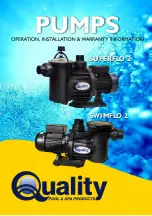
ENGLISH
18
Control laws
6. Starting up
If the pump is delivered as separate part, not integra-
ted into a system we mounted, the standard confi-
guration mode is the external control 0-10V.
6.1 Configurations
The pump is controlled with an external system (see fig.7)
If the pump is integrated in a booster assembled by ourselves, consult
the booster instructions.
In normal operation the state of the leds is as follows (see fig.4) :
State of
Function
LED
Light on
Flashing
Switched off
LED1
Failure
Detected failure
Limit
No failure
RED
alarm
LED2
The pump
The motor is in
The motor
acceleration or
GREEN
turns
deceleration phase
is stopped
LED3
Pump
Pump
/
dead
GREEN
alive
6.2 Preliminary rinsing
Each of our pumps is tested regarding hydraulic features in factory,
some water may remain in them. It is recommended for hygien pur-
poses, to carry out a rinsing of the pump before any using with potable
water supply.
6.3 Filling - degassing
Never operate the pump dry,
even briefly.
Pump under pressure
(see fig. 2)
- Close the discharge valve (item3).
- Open the venting plug (item5), the suction valve (item2) and comple-
tely fill the pump.
- Close the venting plug only after water flows out and complete aeration.
- In hot water, a stream of water may escape from the venting plug port.
- Take all required precautions as regards persons and motor-converter.
Pump in suction
(see fig.1) : two possible cases.
1st case
(see fig.5.1)
- Close the discharge valve (fig.1-item3), open the suction valve (fig.1-
item2).
- Remove the venting plug (fig.1-item5)
- Unscrew about 4 turns the bottom drain-priming plug (fig.1-item 6)
located on the pump casing.
- Put a funnel into the venting plug port and completely fill the pump
and the suction pipe.
- After water flows out and total air exit, filling is achieved.
- Screw the venting plug and the bottom drain-priming plug back in.
2nd case
(see fig.5.2)
- Filling can be made easier by fitting on the suction pipe of the pump, a
vertical pipe (fig.5-item14) fitted with a Ø 1/2" stopcock and a funnel.
- The length of the pipe must be at least 50 mm taller than the venting
plug level.
- Close the discharge valve (fig.1-item3), open the suction valve (fig.1-
item2).
- Open the stopcock (fig.5-item14) and the venting device (fig.1-item5).
- Unscrew about 4 turns the drain-priming plug (fig.1-item 6).
- Completely fill the pump and the suction pipe until water flows out of
the venting plug (fig.1-item5).
- Close the stopcock (fig.5-item14) (which can be left in place), remove
the pipe, close the venting device (fig.1-item5) and screw again the
drain-priming plug (fig.1-item6).
6.4 Starting up
Depending on conveyed fluid and running of pump, surface
temperature can exceed 68°C. Take necessary means to
avoid injuries.
The pump must not operate at zero flow (closed dis-
charge valve) for more than 10 minutes with cold water
(T°C < 40°C) and more than 5 minutes above 60° C.
- We recommend to ensure a minimum flow of about 10 % of the nominal
flow of the pump to avoid the formation of a vapour lock at the top
of the pump.
- Keep the discharge valve closed.
- Start the pump.
- Open draining plug to drain air. If no water leaks within 20s, close the
plug and stop the pump, then wait 20s to allow air to settle.
CAUTION !
CAUTION !
100%
Control signal 0-20mA
0
40%
2
4
20
Input in current (mA)
Frequency
in % of
the pump
rotation
Pump
stop
security
area
100%
Control signal 0-10V
0
40%
1
2
10
Input in a voltage (V)
Frequency
in % of
the pump
rotation
Pump
stop
security
area
CAUTION !




































